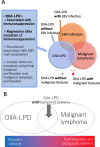Lymphoproliferative disorder during temozolomide therapy; a representative case of a formidable complication and management challenges
- PMID: 37296412
- PMCID: PMC10251676
- DOI: 10.1186/s12883-023-03274-8
Lymphoproliferative disorder during temozolomide therapy; a representative case of a formidable complication and management challenges
Abstract
Background: Lymphoproliferative disorder represents a heterogeneous clinicopathological spectrum characterized by uncontrolled proliferation of lymphocytes. Immunodeficiency is a major trigger of its development. While induction of immunodeficiency is a well-known adverse effect of temozolomide therapy, development of lymphoproliferative disorder following temozolomide therapy has not previously been described.
Case presentation: A patient with brainstem glioma developed constitutional symptoms, pancytopenia, splenomegaly and generalized lymphadenopathy during the 2nd cycle of maintenance therapy following induction therapy with temozolomide. Epstein-Barr virus-infected lymphocytes were observed histopathologically and "other iatrogenic immunodeficiency-associated lymphoproliferative disorder" (OIIA-LPD) was diagnosed. Although discontinuation of temozolomide led to rapid remission, relapse was observed 4 months later. CHOP chemotherapy was induced, resulting in secondary remission. Vigilant follow-up for another 14 months showed radiologically stable brainstem glioma and no further recurrence of OIIA-LPD.
Conclusions: This is the first report documenting OIIA-LPD during temozolomide administration. Timely diagnosis of the disease and discontinuation of the causative agent were considered to be the management of choice. Close monitoring for relapse should be continued. Finding a balance between glioma management and controlling the remission of OIIA-LPD remains to be clarified.
Keywords: Epstein-Barr virus; Glioma; Lymphoproliferative disorder; Temozolomide.
© 2023. The Author(s).
Conflict of interest statement
The authors declare no competing interests.
Figures





Similar articles
-
Primary central nervous system other iatrogenic immunodeficiency-associated lymphoproliferative disorders presenting as extraosseous plasmacytoma with a progressive clinical course: A case report and literature review.Neuropathology. 2023 Apr;43(2):151-157. doi: 10.1111/neup.12863. Epub 2022 Sep 5. Neuropathology. 2023. PMID: 36065518 Review.
-
Spontaneous regression of breast lymphoproliferative disorders after withdrawal of methotrexate in rheumatoid arthritis patients with Epstein-Barr virus infection: a case report and review of the literature.J Med Case Rep. 2022 Feb 7;16(1):49. doi: 10.1186/s13256-022-03274-1. J Med Case Rep. 2022. PMID: 35125110 Free PMC article. Review.
-
Increased MYC expression without MYC gene translocation in patients with the diffuse large B-cell-lymphoma subtype of iatrogenic immunodeficiency-associated lymphoproliferative disorders.J Clin Exp Hematop. 2021;61(3):120-125. doi: 10.3960/jslrt.20025. J Clin Exp Hematop. 2021. PMID: 34511544 Free PMC article.
-
Other iatrogenic immunodeficiency-associated lymphoproliferative disorders in a patient with anti-melanoma differentiation-associated gene 5-positive dermatomyositis: A case report and systematic literature review.Int J Rheum Dis. 2023 Jun;26(6):1172-1177. doi: 10.1111/1756-185X.14608. Epub 2023 Feb 15. Int J Rheum Dis. 2023. PMID: 36789793
-
Clinicopathological findings, prognosis, and Epstein-Barr virus infection in rheumatoid arthritis patients with other iatrogenic immunodeficiency-associated T- and NK-cell lymphoproliferative disorders.BMC Cancer. 2022 Dec 22;22(1):1342. doi: 10.1186/s12885-022-10358-0. BMC Cancer. 2022. PMID: 36544095 Free PMC article.
References
-
- Ogawa A, Nakagawa T, Kumaki Y, Hosoya T, Oda G, Mori M, et al. Spontaneous regression of breast lymphoproliferative disorders after withdrawal of methotrexate in rheumatoid arthritis patients with Epstein-Barr virus infection: a case report and review of the literature. J Med Case Rep. 2022;16 1:49; 10.1186/s13256-022-03274-1. - PMC - PubMed
Publication types
MeSH terms
Substances
LinkOut - more resources
Full Text Sources
Research Materials

